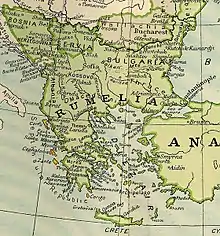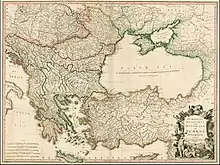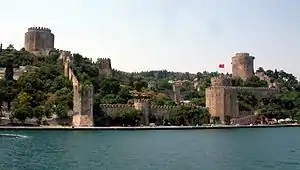Rumelia
Rumelia (Ottoman Turkish: روم ايلى, Rūm-ėli; Modern Turkish: Rumeli; Greek: Ρωμυλία), etymologically "Land of the Romans", was the name of a historical region in Southeastern Europe that was administered by the Ottoman Empire, corresponding to the Balkans. In its wider sense, it was used to refer to all Ottoman possessions and vassals that would later be geopolitically classified as "the Balkans".

Etymology

Rûm means "Roman" or "Greek", ėli means "land" and Rumelia (Ottoman Turkish: روم ايلى, Rūm-ėli; Turkish: Rumeli) means "Land of the Romans" in Ottoman Turkish. It refers to the lands conquered by the Ottoman Empire in the Balkans, which formerly belonged to the Byzantine Empire, known by its contemporaries as the Roman Empire (German historian Hieronymus Wolf coined the neologism "Byzantine Empire" in 1557, more than a century after the fall of Constantinople in 1453, in his work Corpus Historiæ Byzantinæ.)[1] Although the term Byzantine Empire is used by modern historians, the empire's citizens and emperors called themselves Romans and embraced a Roman identity. Various languages in the Balkans have long used the descriptor "Roman" to refer to the lands of the former Eastern Roman (Byzantine) Empire. Indeed, today the term survives in the region as Bosnian: Rumelija, Greek: Ρωμυλία, Romylía, or Ρούμελη, Roúmeli; Albanian: Rumelia; Macedonian and Serbian: Румелија, Rumelija and Bulgarian: Румелия, Rumeliya. The old Latin documents in Genoa use the term Romania, the common name for the Byzantine Empire during the Middle Ages.
Originally, the Seljuks used the name "Land of the Rûm" (Romans) to define Anatolia, which the armies of the Seljuk Empire gradually conquered from the former Eastern Roman Empire after the Battle of Manzikert in 1071. The Anatolian Seljuk Sultanate was called the Sultanate of Rum by its contemporaries, meaning the "Sultanate of the Roman Empire" or "Roman Sultanate", which mostly covered central Anatolia until the Battle of Köse Dağ in 1243. Afterwards, it was replaced by the Anatolian beyliks, among which the Ottoman Beylik rose to prominence in the 14th and 15th centuries and eventually became the Ottoman Empire.
However, following the expansion of the Ottoman Empire into Anatolia and the Balkans in the second half of the 14th century and after the conquest of Constantinople (now Istanbul) in 1453 by Mehmed II, the term Rumeli ("Land of the Romans") came to apply exclusively to the Balkan region of the Ottoman Empire. The region remained primarily populated by Christians; though gradually, the Albanians, Bosniaks and Pomaks, among others, converted to Islam.
Many grand viziers, viziers, pashas and beylerbeyis were originally from Rumelia.
Geography

Rumelia included the provinces of Thrace, Macedonia and Moesia, which are now Bulgaria and Turkish Thrace, bounded to the north by the rivers Sava and Danube, west by the Adriatic coast and south by the Morea.[2] The name "Rumelia" was ultimately applied to a province composed of central Albania and northwestern Macedonia, with Bitola being the main town.
Following the administrative reorganization made by the Ottoman government between 1870 and 1875, the name Rumelia ceased to correspond to any political division. Eastern Rumelia was constituted as an autonomous province of the Ottoman Empire by the Treaty of Berlin (1878),[2] but on September 6, 1885, after a bloodless revolution, it was united with Bulgaria.[3] The Kosovo Vilayet was created in 1877.[4]
In Turkey, the word Trakya (Thrace) has now mostly replaced Rumeli (Rumelia) to refer to the part of Turkey that is in Europe (the provinces of Edirne, Kırklareli, Tekirdağ, the northern part of Çanakkale Province and the western part of Istanbul Province). However, "Rumelia" remains in use in historical contexts and is still used in the context of the culture of the current Turkish populations of the Balkans and the descendants of Turkish immigrants from the Balkans. The region in Turkey is also referred to as Eastern Thrace, or Turkish Thrace. In Greece, the term Ρούμελη (Rumeli) has been used since Ottoman times to refer to Central Greece, especially when it is juxtaposed with the Peloponnese or Morea. The word Rumeli is also used in some cases, mostly in Istanbul, to refer exclusively to the part of Istanbul Province that is west of the Bosphorus strait.
See also
- Turks in the Balkans
- Sultanate of Rum
- Rum Millet
- Millet (Ottoman Empire)
- Ottoman wars in Europe
- Ottoman Greece
- Ottoman Bulgaria
- Ottoman Vardar Macedonia
- Ottoman Serbia
- Ottoman Bosnia and Herzegovina
- Ottoman Croatia
- Ottoman Albania
- Ottoman Montenegro
- Ottoman Kosovo
- Ottoman Romania
- Ottoman Moldova
- Ottoman Hungary
- Ottoman Slovakia
- Ottoman Ukraine
- Ada Kaleh
- Upper Thracian Plain — in Bulgaria.
- Western Thrace — in Greece.
- Septinsular Republic
References
- Encyclopædia Britannica – Rumelia at Encyclopædia Britannica.com
- Reclus, Onésime; Ibáñez, Vicente Blasco; Reclus, Élisée; Doré, Gustave (1907). Novísima Geografía Universal (in Spanish). Madrid La Edit. Española-Americana. p. 636. OCLC 432767489.
- Frucht, Richard (2004). Eastern Europe: An Introduction to the People, Lands, and Culture. ABC-CLIO. p. 807. ISBN 1576078000.
- Verena Knaus; Gail Warrander (2010). Kosovo. Bradt Travel Guides. p. 11. ISBN 978-1841623313.
Sources
- Bronza, Boro (2010). "The Habsburg Monarchy and the Projects for Division of the Ottoman Balkans, 1771-1788". Empires and Peninsulas: Southeastern Europe between Karlowitz and the Peace of Adrianople, 1699–1829. Berlin: LIT Verlag. pp. 51–62. ISBN 9783643106117.CS1 maint: ref=harv (link)
External links
- . Encyclopædia Britannica. 23 (11th ed.). 1911.